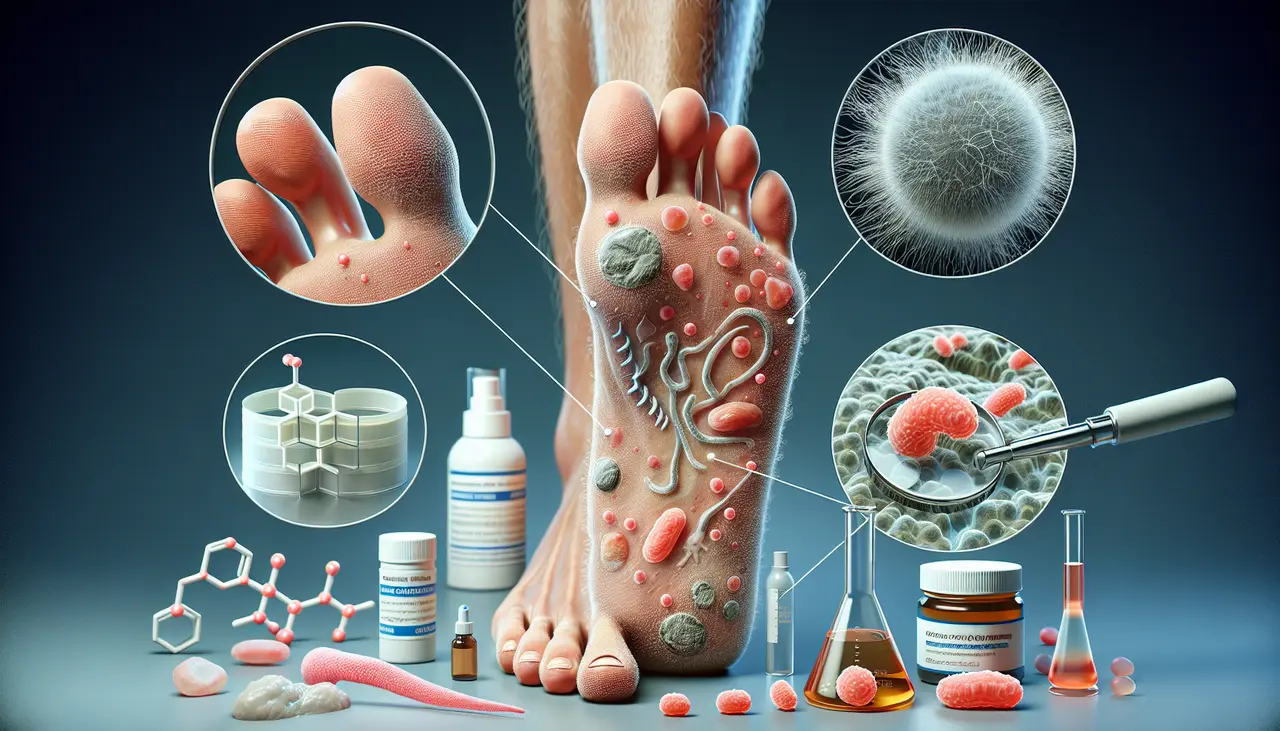Understanding Athlete’s Foot: A Brief Overview
Athlete’s foot, known in the science world as tinea pedis, strikes when a certain pesky fungus finds a cozy home in the warm, moist areas between your toes. It’s a common condition, especially if you’re somebody who hits the gym regularly or is always on the move in tight, sweaty shoes. This fungus loves to grow in places like locker rooms, swimming pools, and even your favorite running socks if they’re damp enough. When it takes hold, you’ll know it: itching, burning sensations, and peeling skin are the unwelcome signs. So, when you’re dealing with these symptoms, it means that fungus has declared war on your feet, and it’s time to fight back with some effective remedies.
Common Causes and Symptoms of Athlete’s Foot
Athlete’s foot sneaks up when fungus finds a home on your feet. This uninvited guest loves damp, tight spaces where it can thrive, so your sweaty sneakers after a gym session are a perfect spot. Look out for itching, stinging, and burning between your toes or on the soles of your feet. You might also see peeling, redness, and sometimes blisters, which are telltale signs this fungus has moved in. If your foot itches more than an ant on a jelly donut, and you spot these symptoms, chances are you’ve got athlete’s foot. Best to tackle it fast before it spreads to nails or other body parts.
The Science of Athlete’s Foot Remedies
Athlete’s foot can be a real nuisance, but science offers solutions. It’s caused by a fungus and enjoys damp, cramped spaces like the inside of a shoe. To kick it, antifungal treatments come into play. These can be creams, sprays, or powders, and they work by attacking the fungus’s cell walls, knocking out the culprit behind the itch and burn. It’s essential to use the product as directed and keep at it for the full treatment period – even if symptoms vanish, the fungus could rally for a comeback if not thoroughly defeated. Keeping feet dry and clean, giving shoes a break to air out, and opting for moisture-wicking socks are also smart moves to stop athlete’s foot in its tracks. Science shows persistence and proper foot hygiene are key to clearing up this pesky infection.
Over-the-Counter Treatments: Pros and Cons
When you’re tackling athlete’s foot, you’ve got a pit crew of over-the-counter treatments ready to jump in. These remedies are like the first line of defense—they’re easy to find and you can grab them without a doc’s note. You’ll see stuff like antifungal creams, sprays, and powders. Now, these bad boys can be pretty effective, especially if you catch the fungus early. Plus, they’re usually cheaper than prescription meds, and you can start attacking those itchy critters right away.
But it’s not all victory laps with OTC treatments. Sometimes, the fungus is stubborn—like that last bit of grime that won’t come off your tire. So you might apply the cream or spray for weeks, but the athlete’s foot just keeps waving its checkered flag. And if you’ve got sensitive skin, some products might cause irritation—like a rash that no one wants as a pitstop souvenir. Plus, if you don’t use them correctly or for long enough, the fungus can come roaring back, and nobody wants a repeat race with athlete’s foot.
Prescription Medications for Athlete’s Foot
For tough cases of athlete’s foot, over-the-counter remedies won’t cut it. You’ll need to see a doc and get yourself some prescription medications. We’re talking about antifungal pills and creams tailored to blast those fungi away for good. Usually, your doctor decides what to prescribe after checking out the severity of your foot fungus. So, the big guns like itraconazole, terbinafine, or fluconazole might come into play. But remember, in the battle against athlete’s foot, these meds might have side effects, and you’ll have to stick with the treatment for a couple of weeks to nail it. Each type of medication has its own marching orders, and your doc will tell you how to follow them to the letter. Keep your feet clean and dry while you’re on these meds, and you’ll give that foot fungus the boot.
Home Remedies and Natural Solutions
When it comes to treating athlete’s foot, you might want to first try some home remedies or natural solutions. Trust me, you’ve got several simple yet effective options lying around your home. One classic approach is soaking your feet in a mix of water and vinegar, which can create an environment hostile to the fungus causing the trouble. Just mix one part vinegar with two parts water and submerge your feet for about 20 minutes daily. Another route is applying a garlic paste directly to the affected area. Garlic has antifungal properties that can help knock out the fungus. Crush a few cloves, mix with water to form a paste, and use it on your skin. Now, if you like tea, you’ve got another weapon in your pantry. Tea contains tannic acid which can dry out sweaty feet and stop the fungus in its tracks. Brew five bags in a quart of water and soak your feet for around half an hour. Lastly, don’t forget about good old air and sunlight. Fungus hates dry, sunny spaces, so let those feet breathe and catch some rays. Be persistent with these natural remedies, but if you see no improvement, it’s time to get a tougher game plan and consult a professional.
The Role of Foot Hygiene in Treating Athlete’s Foot
Keeping your feet clean and dry is critical in treating athlete’s foot. This condition thrives in moist environments, so you strike a blow against it every time you practice good foot hygiene. Start by washing your feet with soap and water daily, making sure to dry them thoroughly, especially between the toes. It’s also smart to wear breathable footwear and moisture-wicking socks, which help keep your feet dry throughout the day. If your feet tend to sweat a lot, consider changing socks midday. Maintain a regular foot hygiene routine and soon you’ll create an environment where athlete’s foot struggles to hold its ground.
Preventing Athlete’s Foot: Tips and Tricks
An ounce of prevention is worth a pound of cure, especially when dealing with athlete’s foot. Keep the fungus at bay with these straightforward strategies. Always dry your feet completely, as the fungus thrives in moisture. Opt for breathable footwear to keep your feet dry throughout the day, and switch out your shoes regularly to let them air out. Socks matter too – choose ones that wick away sweat. Remember to wear flip-flops in public showers or locker rooms and consider using antifungal powders or sprays regularly if you’re prone to sweaty feet. Implement these simple habits, and you’ll reduce your chances of facing the pesky problem of athlete’s foot.
When to Seek Professional Help for Athlete’s Foot
If your athlete’s foot is stubborn and creams from the pharmacy aren’t cutting it, it’s time to call in the pros. Say the itching hasn’t quit after a couple of weeks, your foot’s all red and angry, or it’s spread to your nails, these are clear signs you need a doctor. They’ll probably give you stronger stuff, maybe pills or fancy creams. And if your toes are in on the action, looking all thick and crusty, that could be a fungal nail infection hitching a ride with the athlete’s foot. A doctor’s visit is the move then. Remember, if diabetes is part of your story or your immune system isn’t up to snuff, don’t gamble. Get to a healthcare pro pronto. They’ll get you sorted.
Conclusion: Managing and Overcoming Athlete’s Foot
When it comes to athlete’s foot, preventing the infection from taking hold is your best strategy. Make sure to keep your feet dry, wear breathable footwear, and change your socks daily. If you find yourself with this pesky fungal infection, act quickly. Over-the-counter antifungal creams and powders can be effective. For stubborn cases, a trip to the doctor might be necessary. Remember, maintaining good foot hygiene and monitoring for early signs of athlete’s foot are key. Treatments work, but re-infections can happen, so stay vigilant to keep your feet clear and healthy.

